Equipment
- MALDI-TOF-TOF
- nano-LC-ESI-MS/MS
- 5500 QTRAP-ESI-MS
- Q-Exactive Plus Mass Spectrometer
- Automated Protein Digestions and Spotpicking
Additional Equipment
- Microarray Scanner
- 2D Gelelectrophoresis
- TyphoonTrio+ variable mode imager
MALDI-TOF-TOF

The AutoflexIII (Bruker Daltonics) is an orthogonal MALDI-TOF-TOF-system that offers high mass accuracy and resolution in both positive and negative ionization modes. The mass accuracy for metabolites and peptides can reach 5 ppm which is equal to +/- 0,005 Da at m/z = 1000. The instrument also offers MS/MS capabilities that can be used to obtain structural information by fragmentation of biomolecules. Using MS/MS analysis identifications of metabolites or Peptide Mass Fingerprint (PMF) identifications of proteins can be verified.
Applications:
- Identification of proteins from 1D-, 2D- or 2D DIGE-gels (PMF, Peptide Mass Fingerprint)
- Mass determination of peptides, proteins, oligosaccharides, oligonucleotides etc. for quality control or identification
- Top-Down mass spectrometry of intact proteins using in-source-decay (ISD). MALDI-ISD of intact proteins enables N-terminal sequencing of proteins.
nano-LC-ESI-MS/MS (Analysis of Proteins, Proteomics)
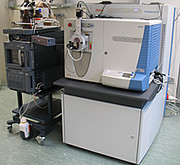
For a detailed characterization of proteins and their post-translational modifications two Fourier Transform (FT) electrospray mass spectrometers are available. Both FT-ESI mass spectrometers are coupled to nano UHPLC systems to facilitate chromatographic separation of peptides before mass spectrometry analysis.
The LTQ-Orbitrap XL (Thermo Fisher Scientific) is a hybrid Fourier Transform (FT) electrospray mass spectrometer with high sensitivity and high mass accuracy which enables unambiguous identification of proteins and their post-translational modifications. The system combines two mass analyzers, a linear ion trap (LIT) and an electrostatic ion trap (Orbitrap) that work in parallel. The LIT has high scan speed; the Orbitrap offers high mass accuracy (≤ 1 ppm) and high resolution (up to 100,000). Peptides and proteins can be fragmented either in the linear ion trap (CID, including MSn) or in the collision cell (HCD) which provides maximum flexibility for MS/MS experiments and leads to comprehensive peptide sequence information. The instrument is operated on-line with a nanoACQUITY UPLC system (Waters). The nanoACQUITY facilitates non-split gradient nanoflow chromatographic separations in the range of 200 nl/min to 100 µl/min. The application of low flow rates in combination with nanoflow columns (75 µm inner diameter) provides high sensitivity for the mass spectrometry analysis of peptides and proteins.

For the analysis of highly complex protein extracts access to a Q-Exactive Plus mass spectrometer (Thermo Fischer Scientific) is available, which is located in the department of “Plant Systems Biology” (260b, Prof. Waltraud Schulze). The instrument is coupled to an EASY-nLC 1000 nano-UHPLC system (Thermo Fisher Scientific) and is exclusively used for the analysis of proteins and peptides. Compared to the Orbitrap XL mass spectrometer the Q-Exactive Plus has a second generation orbitrap mass analyzer that allows higher acquisition rates of MS- and MS/MS-spectra. Therefore a significantly higher number of proteins can be identified and quantified in complex protein mixtures compared to the Orbitrap XL. In addition the Q-Exactive Plus has an isolation quadrupol that enables SIM (Single Ion Monitoring)- oder PRM (Parallel Reaction Monitoring)-experiments for targeted quantification of single proteins or peptides with similar sensitivity than Triple-Quadrupole or Q-TRAP mass spectrometers.
Applications for both nano-LC-ESI-MS/MS instruments:
- Accurate mass determination of peptides and proteins for quality control or identification
- Identification of proteins from complex mixtures
- Identification of posttranslational protein modifications
- Relative and absolute protein quantification (with isotope labelling or label free)
- Proteomics (Q-Exactive Plus only)
- Targeted quantification of proteins and peptides using SIM or PRM (Q-Exactive Plus only)
The following software products are available for the analysis of protein mass spectrometry data:
- Mascot Server 2.6 (Matrix Science)
- Proteome Discoverer 2.1 (Thermo Fisher Scientific)
- Scaffold 4.6.1 (Proteome Software)
- MaxQuant 1.5.5.1 (MPI für Biochemie, AG Cox/Mann)
- Perseus 1.5.5.3 (MPI für Biochemie, AG Cox/Mann)
- Progenesis LCMS 4.1.4 (Nonlinear Dynamics)
5500 QTRAP-ESI Mass Spectrometer (Analysis of Metabolites, Metabolomics)
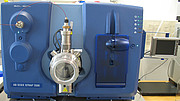
The 5500 QTRAP ESI-MS (AB SCIEX) system is mainly used for the targeted quantification of metabolites. For the analysis of peptides and proteins a nano-spray ion source is available. Metabolites or peptides with known m/z ratio can be detected and quantified with high sensitivity even in very complex mixtures by SRM (Selected Reaction Monitoring) or MRM (Multiple Reaction Monitoring). In a SRM experiment combinations of a precursor ion and one or more characteristic fragment ions of the metabolite of interest are analyzed. Since for both precursor ion and fragment ions only very narrow m/z ranges are selected by the quadrupoles (usually 1 Da) the chemical background is low and therefore the metabolite of interest can be detected with high sensitivity.
In contrast to Triple-Quadrupole mass spectrometers the 5500 QTRAP is a hybrid system including a linear ion trap (LIT) that can be used as quadrupole or LIT. Due to the high acquisition speed of the LIT MS/MS or MS3 scans can be acquired during an SRM quantification experiment to confirm of the metabolite identity. Furthermore the 5500 QTRAP can be used for precursor ion or neutral loss scan experiments to screen for the presence of certain substance classes or modifications (for example lipids, glycosylation, phosphorylation, etc.) within a sample. The LIT can also used within these screening experiments to record data dependent MS/MS spectra for metabolite or peptide identification.
For the analysis of proteins the 5500 QTRAP is coupled to a nano-UHPLC-system whereas the QTRAP is coupled to a 1290 Infinity UHPLC system (Agilent) for the analysis of metabolites. The 1290 Infinity UHPLC can be operated at flow rates of ≤ 2 ml/min and up to 1200 bar backpressure. This allows the application of UHPLC columns with < 2 µm particle size, which leads to higher peak capacities and higher MS signal intensities compared to a standard HPLC.
Applications:
- Targeted quantification of metabolites and proteins by SRM/MRM experiments.
- Absolute quantification of metabolites and proteins by SRM/MRM experiments with internal standard.
- Precursor ion or neutral loss scans for the identification of certain substances classes or modifications.
Q-Exactive Plus Mass Spectrometer
Since September 2016 a high resolution Q-Exactive Plus (Thermo Fisher Scientific) mass spectrometer for the analysis of small molecules and metabolites is available at the CFH. The Q-Exactive Plus is coupled to a 1290 Infinity-UHPLC system (Agilent) for chromatographic separation of metabolites. The Q-Exactive Plus can be operated at resolutions up to 140.000 (at m/z = 200) and offers high mass accuracy for MS (≤ 1 ppm) and MS/MS spectra. The high mass accuracy of the instrument allows precise determination of the m/z ratio of an unknown metabolite, which is usually sufficient to calculate a sum formula. MS/MS spectra can be used for further characterization of a metabolite and can be compared to MS/MS reference databases (if available), which finally can lead to the identification of an unknown metabolite.
In addition the Q-Exactive Plus has a high dynamic range (4-5 orders of magnitude) and a high acquisition speed in MS and MS/MS mode. Therefore many metabolites can be detected in a single analysis with sufficient data points for a precise quantification. This is particularly important for metabolite profiling or metabolite fingerprint experiments. The idea behind these experiments is to detect, identify and (relatively) quantify as many substances as possible. Comparison of metabolic profiles of a biological system under different environmental conditions leads to a better understanding of the regulatory processes within the biological system.
Applications:
- Identification of metabolites by determining their precise m/z ratio
- Fragmentation of metabolites for structural elucidation.
- Metabolite Profiling/Metabolomics (relative Quantification)
- Targeted Quantification (relative or absolute) of metabolites using SIM (Single Ion Monitoring)or PRM (Parallel Reaction Monitoring)
Automated Protein Digestions and Spot Picking
For high-throughput 2D-Eectrophoresis or 2D DIGE experiments a spot picker (Ettan Spot Picker, GE Healthcare) and a protein digesting robot (DigestPro MSi, Intavis) are available. With these devices up to 96 samples can be processed in parallel over night and prepared for the mass spectrometry analysis by MALDI-TOF-TOF or nano-LC-ESI-MS/MS. ZipTip preparation and sample spotting on the MALDI target for the MALDI-TOF-TOF analysis can also be automated using the DigestPro MSi.
Additional Equipment
For high-throughput 2D-Eectrophoresis or 2D DIGE experiments a spot picker (Ettan Spot Picker, GE Healthcare) and a protein digesting robot (DigestPro MSi, Intavis) are available. With these devices up to 96 samples can be processed in parallel over night and prepared for the mass spectrometry analysis by MALDI-TOF-TOF or nano-LC-ESI-MS/MS. ZipTip preparation and sample spotting on the MALDI target for the MALDI-TOF-TOF analysis can also be automated using the DigestPro MSi.
Microarray Scanner
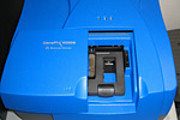
The GenePix 4000B Microarray Scanner (Molecular Devices) allows the acquisition and analysis of fluorescent DNA- and protein arrays on standard glass microscopy slides (25 mm × 75 mm). The scanner has two lasers with excitation wavelengths of 532 nm and 635 nm and can acquire data simultaneously, which dramatically reduces scan times (approximately 14 min at maximum resolution of 5 µm) and provides real-time access to data as they are acquired. The lasers and filters are optimized for Cy3 and Cy5 dyes, but dyes with spectra similar to Cy3 and Cy5 will also give good results. For more information you can visit the manufacturers’ webpage (Molecular Devices). Two software packages are available for data analysis: GenePixPro for data acquisition and first stages of analysis (localization of features, normalization). Advanced statistical analysis and visualization of the data including comparison with data obtained on other platforms (Affimetrix) can be carried out with the Acuity Software. Hybridization chambers for sample preparation are available at the CFH on request.
2D Gelelectrophoresis
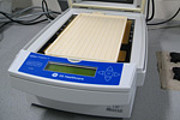
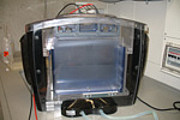
For 2D-electrophoresis experiments an isoelectric focussing system (IPGphor3 (GE Healthcare) and a vertical electrophoresis-unit Ettan Daltsix (GE Healthcare) for large gels (26 × 20 cm) are available. In the first dimension (IEF) up to 12 IPG strips of different lengths (7-24 cm) can be processed simultaneously. In the second dimension (SDS-PAGE) up to six large format gels (26 × 20 cm) can be run in 4-5 h using the Ettan Daltsix electrophoresis unit.
TyphoonTrio+ variable mode imager

The Typhoon Trio+ Imaging System (GE Healthcare) is a versatile imaging platform that can be used for a variety of applications:
Autoradiography of different radio-isotopes: 3H, 14C, 32P, 33P, 35S, 125I (with storage phosphor screen plates).
Chemiluminescence: direct, sensitive detection of chemiluminescence without applying a film or screen (Western Blots).
Fluorescence: the system has 3 lasers with excitation wavelengths of 488 nm (blue), 532 nm (green) and 633 nm (red) and a wide set of emission filters. This allows the application of a large number of commercially available fluorophores. In addition the analysis of up to four fluorophores in one analysis (»Multiplexing«) is possible, for example in differential protein expression analysis using 2D DIGE.
The instrument handles agarose and polyacrylamide gels, membranes and microplates. Data analysis can be carried out with ImageQuantTL Software. A software package for statistical evaluation of 2D DIGE gels is also available (Progenesis SameSpots 4.1.4).
